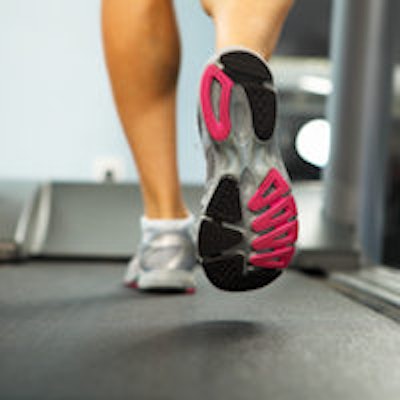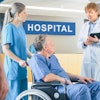
Stand up. Stroll. Fidget. These actions might seem small, but even minor steps can help radiologists counter the major health risks from so many hours spent sitting in front of screens. And it can be done without sabotaging performance, according to a recent article in the American Journal of Roentgenology.
Sitting and sedentary behavior have been shown to compromise health, and diagnostic radiologists have one of the most sedentary careers in medicine, wrote the group led by Dr. Jason Hoffmann from Winthrop-University Hospital in Mineola, NY.
After reviewing radiology and nonradiology research alike, the authors came up with several suggestions to improve health in the reading room, ranging from watching what and when you eat to adding basic exercises that can be performed at the workstation.
"As the prior generation of radiologists implemented changes to protect themselves from the health risks associated with radiation, contemporary radiologists must also implement basic changes into their work routine to protect themselves from the occupational hazards of sedentary work behavior," they wrote. "These changes can be easily and efficiently made, are low-cost, and lead to increased activity" (AJR, April 8, 2016).
Hitting the gym may not be enough
Previous research has connected sedentary behavior with conditions such as heart disease, diabetes, and hypertension, Hoffmann and colleagues noted.
Among several other studies, they cited a 2015 meta-analysis from Biswas et al in the Annals of Internal Medicine that found an association between prolonged sedentary time and all-cause mortality, cardiovascular disease mortality, cardiovascular disease incidence, cancer mortality, cancer incidence, and type 2 diabetes.
In fact, sitting can even undo the positive effects of regular exercise, Hoffmann's group wrote. Even in otherwise physically active adults, too much sitting can slow the metabolism and hurt cardiac health.
While radiologists are likely aware of the negative effects of sedentary behavior, they may not realize the seriousness of the risk and the many conditions that can develop, Hoffmann told AuntMinnie.com by email.
"I don't think that most radiologists realize there are many simple ways to attempt to address these health risks," he said.
Pump up your everyday tasks
The suggestions offered by Hoffmann and colleagues focus on nonexercise activity thermogenesis, which refers to the energy we expend going about daily tasks in life -- basically everything other than sleeping, eating, and intensive exercise. This type of energy output can be increased to lower the risks of sedentary behavior, they believe.
These tasks can include the following:
Stand and/or fidget. One option is to use a standing desk at work, alternating between periods of standing and sitting. Even fidgeting -- which includes actions like typing, using your computer mouse, or tapping your foot -- increases the amount of energy expended. A 2000 study from Levine et al in the American Journal of Clinical Nutrition found that sitting and fidgeting boosted energy expenditure roughly 54% over sitting motionless, while standing and fidgeting bumped the increase to 94% over baseline, Hoffmann and colleagues wrote.
A separate study from the U.K. of more than 10,000 women suggested that moderate to large amounts of fidgeting could eliminate the 30% increased risk of all-cause mortality in sedentary women.
Walk more -- perhaps with a treadmill. If fidgeting is helpful, then it makes sense that walking is even better. Treadmill workstation equipment is available, and while more studies are needed, some research indicates it could provide health benefits without significantly hurting performance, according to the authors.
Even if the jury is still out on workstation treadmills, there are many other ways to incorporate walking into your workday, they suggested. This can include taking a walk at lunch, taking the stairs up and down instead of the elevator, parking farther away from buildings, and even using a smaller cup or bottle to necessitate more frequent trips to the water cooler.
Instead of picking up the phone or sending an email, radiologists can walk to deliver a message or consult with another physician, providing the added benefit of improved communication outside of the reading room. The authors recommend aiming for an overall goal of 10,000 steps per day.
Try some sitting stretches. Performing exercises while seated also can be useful. Hoffmann and colleagues give the following examples:
- Leg lifts, with each leg straightened in front of you
- Seated spinal twists, in which you rotate your torso to the right and then left
- Side stretches, with each arm raised above your head as you lean to the side
- Neck rolls
Such movements can be done intermittently at the PACS workstation, increasing "energy expenditure while at work, while also counteracting fatigue and metabolism decreases that occur during periods of sedentary behavior," they wrote.
More water and watch your calories. Certainly what we eat and drink also factors into our health, and the authors noted that drinking water has many benefits, including appetite suppression. Eating water-rich or high-fiber foods can also result in individuals feeling fuller for longer, in addition to the general health benefits of a high-fiber diet.
Based on their review of the literature, the authors noted that there seems to be disagreement about the health benefits of eating smaller meals more frequently throughout the day, versus having fewer but larger meals. The overall finding is that it's important to balance the daily number of calories taken in with the number expended, regardless of how meals are spaced. That said, the authors did state that it may be better to avoid eating later in the evening, within a couple of hours of bedtime.
Who has the time?
With the changes in imaging volume and reimbursement, most radiologists would say they work harder these days, with more time spent sitting and less time available to exercise, Hoffmann said. Therefore, the authors' goal was to share knowledge about "time-efficient activities and exercises that can be incorporated into the workday of even the busiest diagnostic radiologist."
In addition, using an activity tracker such as Fitbit or setting up some friendly competition among coworkers can help, along with gradually easing into any changes.
"All of these improvements can be made in a progressive manner, because this will likely lead to increased adoption rate and overall compliance with the regimen," the authors wrote.
Further research includes outcomes projects to gauge how educational lectures and demonstrations would affect radiologists' knowledge about these topics, according to Hoffmann.
"In addition, we plan to develop a more quantitative study that evaluates specific health measurements before and after implementing changes to work routine that we detailed in our article in AJR," he said.



















